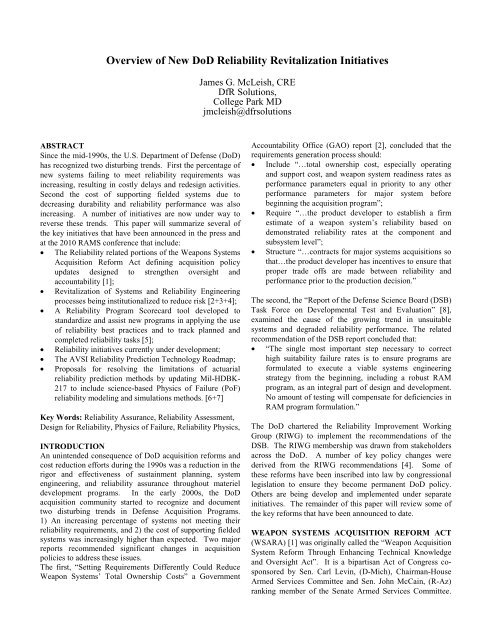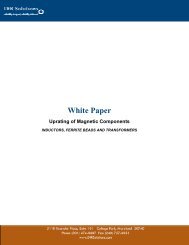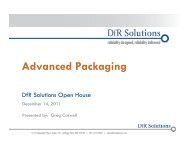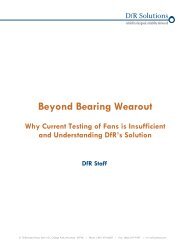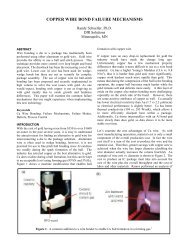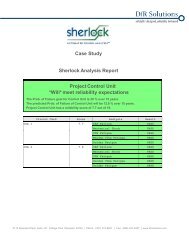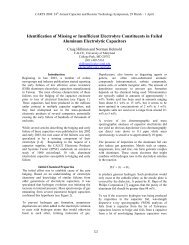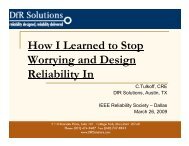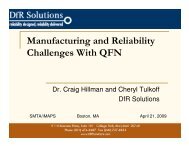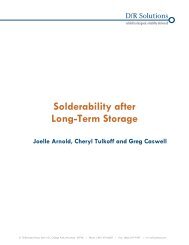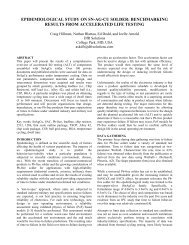Overview of New DoD Reliability Revitalization ... - DfR Solutions
Overview of New DoD Reliability Revitalization ... - DfR Solutions
Overview of New DoD Reliability Revitalization ... - DfR Solutions
You also want an ePaper? Increase the reach of your titles
YUMPU automatically turns print PDFs into web optimized ePapers that Google loves.
<strong>Overview</strong> <strong>of</strong> <strong>New</strong> <strong>DoD</strong> <strong>Reliability</strong> <strong>Revitalization</strong> Initiatives<br />
James G. McLeish, CRE<br />
<strong>DfR</strong> <strong>Solutions</strong>,<br />
College Park MD<br />
jmcleish@dfrsolutions<br />
ABSTRACT<br />
Since the mid-1990s, the U.S. Department <strong>of</strong> Defense (<strong>DoD</strong>)<br />
has recognized two disturbing trends. First the percentage <strong>of</strong><br />
new systems failing to meet reliability requirements was<br />
increasing, resulting in costly delays and redesign activities.<br />
Second the cost <strong>of</strong> supporting fielded systems due to<br />
decreasing durability and reliability performance was also<br />
increasing. A number <strong>of</strong> initiatives are now under way to<br />
reverse these trends. This paper will summarize several <strong>of</strong><br />
the key initiatives that have been announced in the press and<br />
at the 2010 RAMS conference that include:<br />
The <strong>Reliability</strong> related portions <strong>of</strong> the Weapons Systems<br />
Acquisition Reform Act defining acquisition policy<br />
updates designed to strengthen oversight and<br />
accountability [1];<br />
<strong>Revitalization</strong> <strong>of</strong> Systems and <strong>Reliability</strong> Engineering<br />
processes being institutionalized to reduce risk [2+3+4];<br />
A <strong>Reliability</strong> Program Scorecard tool developed to<br />
standardize and assist new programs in applying the use<br />
<strong>of</strong> reliability best practices and to track planned and<br />
completed reliability tasks [5];<br />
<strong>Reliability</strong> initiatives currently under development;<br />
<br />
<br />
The AVSI <strong>Reliability</strong> Prediction Technology Roadmap;<br />
Proposals for resolving the limitations <strong>of</strong> actuarial<br />
reliability prediction methods by updating Mil-HDBK-<br />
217 to include science-based Physics <strong>of</strong> Failure (PoF)<br />
reliability modeling and simulations methods. [6+7]<br />
Key Words: <strong>Reliability</strong> Assurance, <strong>Reliability</strong> Assessment,<br />
Design for <strong>Reliability</strong>, Physics <strong>of</strong> Failure, <strong>Reliability</strong> Physics,<br />
INTRODUCTION<br />
An unintended consequence <strong>of</strong> <strong>DoD</strong> acquisition reforms and<br />
cost reduction efforts during the 1990s was a reduction in the<br />
rigor and effectiveness <strong>of</strong> sustainment planning, system<br />
engineering, and reliability assurance throughout materiel<br />
development programs. In the early 2000s, the <strong>DoD</strong><br />
acquisition community started to recognize and document<br />
two disturbing trends in Defense Acquisition Programs.<br />
1) An increasing percentage <strong>of</strong> systems not meeting their<br />
reliability requirements, and 2) the cost <strong>of</strong> supporting fielded<br />
systems was increasingly higher than expected. Two major<br />
reports recommended significant changes in acquisition<br />
policies to address these issues.<br />
The first, “Setting Requirements Differently Could Reduce<br />
Weapon Systems’ Total Ownership Costs” a Government<br />
Accountability Office (GAO) report [2], concluded that the<br />
requirements generation process should:<br />
Include “…total ownership cost, especially operating<br />
and support cost, and weapon system readiness rates as<br />
performance parameters equal in priority to any other<br />
performance parameters for major system before<br />
beginning the acquisition program”;<br />
Require “…the product developer to establish a firm<br />
estimate <strong>of</strong> a weapon system’s reliability based on<br />
demonstrated reliability rates at the component and<br />
subsystem level”;<br />
Structure “…contracts for major systems acquisitions so<br />
that…the product developer has incentives to ensure that<br />
proper trade <strong>of</strong>fs are made between reliability and<br />
performance prior to the production decision.”<br />
The second, the “Report <strong>of</strong> the Defense Science Board (DSB)<br />
Task Force on Developmental Test and Evaluation” [8],<br />
examined the cause <strong>of</strong> the growing trend in unsuitable<br />
systems and degraded reliability performance. The related<br />
recommendation <strong>of</strong> the DSB report concluded that:<br />
“The single most important step necessary to correct<br />
high suitability failure rates is to ensure programs are<br />
formulated to execute a viable systems engineering<br />
strategy from the beginning, including a robust RAM<br />
program, as an integral part <strong>of</strong> design and development.<br />
No amount <strong>of</strong> testing will compensate for deficiencies in<br />
RAM program formulation.”<br />
The <strong>DoD</strong> chartered the <strong>Reliability</strong> Improvement Working<br />
Group (RIWG) to implement the recommendations <strong>of</strong> the<br />
DSB. The RIWG membership was drawn from stakeholders<br />
across the <strong>DoD</strong>. A number <strong>of</strong> key policy changes were<br />
derived from the RIWG recommendations [4]. Some <strong>of</strong><br />
these reforms have been inscribed into law by congressional<br />
legislation to ensure they become permanent <strong>DoD</strong> policy.<br />
Others are being develop and implemented under separate<br />
initiatives. The remainder <strong>of</strong> this paper will review some <strong>of</strong><br />
the key reforms that have been announced to date.<br />
WEAPON SYSTEMS ACQUISITION REFORM ACT<br />
(WSARA) [1] was originally called the “Weapon Acquisition<br />
System Reform Through Enhancing Technical Knowledge<br />
and Oversight Act”. It is a bipartisan Act <strong>of</strong> Congress cosponsored<br />
by Sen. Carl Levin, (D-Mich), Chairman-House<br />
Armed Services Committee and Sen. John McCain, (R-Az)<br />
ranking member <strong>of</strong> the Senate Armed Services Committee.
The Act was based on the 2008 Defense Science Board Task<br />
Force Report on Developmental Test and Evaluation and the<br />
report <strong>of</strong> the RIWG that cited the need to reform the way<br />
<strong>DoD</strong> contracts for and purchases major weapons systems.<br />
<br />
<br />
Sec. 303. Expansion <strong>of</strong> national security objectives <strong>of</strong><br />
the national technology and industrial base.<br />
Sec. 304. Comptroller General reports on costs and<br />
financial info <strong>of</strong> major defense acquisition programs<br />
The Act was introduced Feb. 23, 2009, and it quickly passed<br />
both the Senate and House unanimously (93-0 & 411-0). It<br />
was signed into law on May 22, 2009 by President Obama<br />
who cited the need to end the "waste and inefficiency" in<br />
defense acquisition. The need for such reforms was clearly<br />
demonstrated by external audits like one by the Government<br />
Accountability Office evaluation <strong>of</strong> 95 major defense<br />
projects uncovering cost overruns totaling $295 billion. “It<br />
will strengthen oversight and accountability by appointing<br />
<strong>of</strong>ficials who will be charged with closely monitoring the<br />
weapons systems we're purchasing” [9]. The Congressional<br />
Budget Office estimates that the new reforms will cost about<br />
$55 million dollars and should be in place by the end <strong>of</strong><br />
2010. It is expected that the reforms will save millions if not<br />
billions <strong>of</strong> dollars over the next decade [10].<br />
<strong>Reliability</strong> related portions <strong>of</strong> the Act are intended to reverse<br />
the 20 year trend <strong>of</strong> system development shortcuts in <strong>DoD</strong><br />
acquisition processes, including reductions in the reliability<br />
and acceptance test workforce that have resulted in excessive<br />
cost overruns and delays in weapon systems fielding. The<br />
reliability related items and objectives <strong>of</strong> the key sections <strong>of</strong><br />
the act, summarized below, are designed to revitalize (or<br />
institutionalize) up front system engineering, total life time<br />
planning, competent design analysis, and testing while<br />
improving program and cost oversight:<br />
TITLE I--ACQUISITION ORGANIZATION<br />
Sec. 101. Cost assessment and program evaluation.<br />
Sec. 102. Directors <strong>of</strong> Developmental Test and<br />
Evaluation and Systems Engineering.<br />
Sec. 103. Performance assessments and root cause<br />
analyses.<br />
Sec. 104. Assessment <strong>of</strong> technological maturity.<br />
Sec. 105. Role <strong>of</strong> the combatant command commanders<br />
in identifying joint military requirements.<br />
TITLE II--ACQUISITION POLICY<br />
Sec. 201. Trade-<strong>of</strong>fs among cost, schedule, and<br />
performance objectives.<br />
Sec. 202. Strategies to ensure competition.<br />
Sec. 203. Prototyping requirements.<br />
Sec. 204. Actions to identify and address systemic<br />
problems in major defense acquisition programs.<br />
Sec. 205. Additional requirements for certain major<br />
defense acquisition programs.<br />
Sec. 206. Critical cost growth in major defense<br />
acquisition programs.<br />
Sec. 207. Organizational conflicts <strong>of</strong> interest in major<br />
defense acquisition programs.<br />
TITLE III--ADDITIONAL ACQUISITION PROVISIONS<br />
Sec. 301. Awards for Department <strong>of</strong> Defense personnel<br />
for excellence in acquisition.<br />
Sec. 302. Earned value management.<br />
REVITALIZING SYSTEMS & SUSTAINMENT<br />
One <strong>of</strong> the main reliability effects <strong>of</strong> WSARA is the<br />
codification <strong>of</strong> key findings and recommendations in the<br />
GAO report [2+11] regarding incorporating sustainment<br />
planning into the systems engineering process—especially in<br />
the area <strong>of</strong> Total Ownership Cost analysis and control from<br />
the earliest program activities. The DSB 2008<br />
Developmental Test and Evaluation report identified the<br />
importance <strong>of</strong> establishing a viable systems engineering<br />
process at the beginning <strong>of</strong> programs [8]. Unfortunately, the<br />
<strong>DoD</strong> and services systemically dismantled systems<br />
engineering activities beginning in the early 1990’s and<br />
revitalization efforts in the reliability arena are incomplete.<br />
This issue is addressed in WSARA by requiring the <strong>DoD</strong> to:<br />
(1) evaluate if the necessary systems engineering<br />
development planning, lifecycle management and<br />
sustainability capabilities needed to ensure that key<br />
acquisition decisions are supported by a rigorous systems<br />
analysis and systems engineering process are in place and<br />
(2) establish organizations and develop skilled employees<br />
needed to fill any gaps in such capabilities [12]. Similar<br />
capability evaluations and corrective actions are specified for<br />
test and evaluation activities.<br />
Re-establishing these capabilities along with other tasks are<br />
the responsibility <strong>of</strong> the new Directors <strong>of</strong> Developmental<br />
Test and Evaluation (D,DT&E) and Systems Engineering<br />
(D,SE), positions that were created within the Office <strong>of</strong> the<br />
Secretary <strong>of</strong> Defense (OSD) by WSARA.<br />
RELIABILITY PROGRAM SCORECARD [5]<br />
One problem that <strong>of</strong>ten faces government source selection<br />
teams is how to evaluate the ability <strong>of</strong> an <strong>of</strong>feror to develop a<br />
“viable RAM strategy.” The RIWG adapted an Army tool,<br />
the “Army Materiel System Analysis Activity (AMSAA)<br />
Scorecard,” to help in the assessment <strong>of</strong> both the program<br />
<strong>of</strong>fice and contractor’s system reliability efforts. The<br />
scorecard has focus areas for reliability requirements<br />
planning; reliability testing; failure tracking and reporting;<br />
and reliability verification and validation. When applied<br />
early in the program, the scorecard can identify areas for<br />
improvement before significant problems emerge. There are<br />
40 elements organized into the following eight evaluation<br />
categories:<br />
<br />
<br />
<br />
<br />
<br />
<br />
<br />
<br />
Requirements and Planning<br />
Training and Development<br />
<strong>Reliability</strong> Analysis<br />
<strong>Reliability</strong> Testing<br />
Supply Chain Management<br />
Failure Tracking and Reporting<br />
Verification and Validation<br />
<strong>Reliability</strong> Improvements
The scorecard examines a supplier’s use <strong>of</strong> reliability best<br />
practices, as well as the supplier’s planned and completed<br />
reliability tasks. A risk assessment score is calculated based<br />
on the individual reliability risk ratings assigned to each<br />
element. Each element is given a color coded risk rating <strong>of</strong><br />
high (red) which is allotted a score <strong>of</strong> 3, medium (yellow)<br />
which equals 2, low risk (green) which is rated as a 1, or not<br />
evaluated (gray). The elements are weighted and are<br />
normalized to produce a risk score for each <strong>of</strong> the eight<br />
evaluation categories, these are combined into the overall<br />
program score. Elements that are not evaluated are removed<br />
from the risk score calculations. The risk scores for each<br />
element are adjusted by weighting factors to produce an<br />
overall reliability risk normalized to a value between 1 &100.<br />
A low score equates to a low reliability risks and a high score<br />
indicates a high risk correlated to a visual green (go), yellow<br />
(caution), and red (stop) scale.<br />
Figure 1: Overall Program Risk Assessment Example<br />
The scorecard provides an early evaluation <strong>of</strong> RAM<br />
capabilities in an acquisition program while helping to<br />
identify reliability gaps. It provides a guide to help program<br />
<strong>of</strong>fices and contractors think about reliability early in the<br />
acquisition process and throughout the program’s life cycle.<br />
The <strong>Reliability</strong> Program Scorecard is a valuable tool for<br />
evaluating risks and making an early initial reliability<br />
projection for a program. A copy <strong>of</strong> the scorecard can be<br />
obtained from the <strong>DoD</strong> <strong>Reliability</strong> Information and Analysis<br />
Center’s web site, http://www.theriac.org/ under “AMSAA<br />
<strong>Reliability</strong> Growth Tools and Scorecard”.<br />
RELIABILITY INITIATIVES CURRENTLY UNDER<br />
DEVELOPMENT<br />
A number <strong>of</strong> initiatives to permanently institutionalize<br />
reliability activities into major defense acquisition programs<br />
were defined under WSARA.<br />
<strong>Reliability</strong> related duties <strong>of</strong> the new Director, Systems<br />
Engineering position include: using systems engineering<br />
approaches to enhance reliability, availability, and<br />
maintainability (RAM) and ensuring that provisions related<br />
to reliability growth are included in the request for proposals<br />
on major defense acquisition programs.<br />
Acquisition executives <strong>of</strong> military departments and defense<br />
agencies responsible for major defense acquisition programs<br />
are responsible for ensuring that their organizations provide<br />
the System Engineering (SE) and Developmental Test and<br />
Evaluation (DT&E) organizations with appropriate resources<br />
and trained personnel to:<br />
<br />
Define a robust RAM and sustainability program as an<br />
integral part <strong>of</strong> design and development within the<br />
systems engineering master plan;<br />
Identify systems engineering lifecycle management,<br />
RAM, and sustainability requirements and incorporate<br />
them into contract requirements;<br />
<br />
<br />
<br />
Define appropriate developmental testing requirements,<br />
Participate in the planning <strong>of</strong> DT&E activities;<br />
Participate in and oversee DT&E activities, test data<br />
analysis, and test reports.<br />
To develop plans for implementing these initiatives the<br />
Under Secretary <strong>of</strong> Defense for Acquisition, Technology, &<br />
Logistics (AT&L) directed the new <strong>DoD</strong> Director <strong>of</strong> Systems<br />
Engineering to convene a <strong>Reliability</strong> Senior Steering Group<br />
(RSSG) in April 2010. Subordinate <strong>Reliability</strong> Working<br />
Group (RWG) teams were organized and tasked to address<br />
reliability-related issues regarding policy, people, and<br />
practice for reliability across the <strong>DoD</strong>. These teams actively<br />
developed recommendations regarding the reconstitution <strong>of</strong><br />
<strong>DoD</strong> reliability, test, and sustainment related policy, skills,<br />
and processes. Related policy and guidance announcements<br />
are expected in the near future.<br />
AVSI RELIABILITY ROADMAP<br />
The Aerospace Vehicle Systems Institute (AVSI) is a Texas<br />
A&M University research cooperative <strong>of</strong> aerospace<br />
companies, the <strong>DoD</strong>, and the Federal Aviation<br />
Administration that works to improve aerospace vehicles,<br />
their components, systems, and development processes. The<br />
AVSI has undertaken a project to chart the future <strong>of</strong><br />
reliability research by developing a reliability technology<br />
road map for electronics reliability assessment practices.<br />
The AVSI team is applying a Quality Function Deployment<br />
(QFD) process to analyze and prioritize the experiences and<br />
recommendations <strong>of</strong> a large number <strong>of</strong> industry experts to<br />
define future reliability methods and research. A QFD is a<br />
widely used tool to help sort out, identify, and prioritize the<br />
requirements for complex issues in order to transform user<br />
needs and demands into criterion and plans that incorporate<br />
key characteristics from the viewpoint <strong>of</strong> potential end users.<br />
This project has so far generated a prioritized “wish list” <strong>of</strong><br />
64 reliability assessment features that are evaluated by 25<br />
needs criteria. The next step is to evaluate how well existing<br />
or near term reliability assessment/prediction methodologies<br />
or tools fulfill the objectives <strong>of</strong> the wish list items. Current<br />
or near term reliability prediction methods/tools that are<br />
determined to adequately fulfill wish list needs and features<br />
will be identified as easily achievable “Low Hanging Fruit”<br />
items that will be recommended as suitable for immediate<br />
usage in current and new program.
The wish list items that can not be easily implemented in the<br />
short term will be evaluated to estimate the effort needed to<br />
make them happen. These items will be identified as near<br />
term and long term recommended efforts to help influence<br />
the future direction <strong>of</strong> reliability research. The <strong>Reliability</strong><br />
Roadmap results will be provided to the <strong>DoD</strong> for reliability<br />
research planning, future revisions to military and aerospace<br />
handbooks and processes, and to help direct future industry<br />
reliability research and development.<br />
UPDATING MIL-HDBK-217 RELIABILITY<br />
PREDICTION METHODS TO INCLUDE PoF<br />
The <strong>DoD</strong>’s Defense Standardization Program Office (DSPO)<br />
has initiated a multi-phase effort to update MIL-HDBK-217,<br />
the military’s <strong>of</strong>ten imitated and frequently criticized<br />
reliability prediction “bible” for electronics equipment that<br />
has not been updated since 1995 [4+12]. There are numerous<br />
concerns about the actuarial reliability prediction methods<br />
defined in MIL-HDBK-217 which have been covered<br />
thoroughly elsewhere [14+15]. The main concerns are:<br />
1) Currently, 217 predictions are based on constant failure<br />
rates which model only random failure situations that do<br />
not account for infant mortality and wearout issues.<br />
Tabulation errors where infant mortality and wearout<br />
issues are tallied as random failures are another risk <strong>of</strong><br />
this scheme which can produce significant inaccuracy in<br />
predicted failure rates.<br />
2) Actuarial reliability predictions typically correlate poorly<br />
to actual field performance since they do not account for<br />
the physics or mechanics <strong>of</strong> failure. Hence, they cannot<br />
provide insight for controlling actual failure mechanisms<br />
and they are incapable <strong>of</strong> evaluating new technologies<br />
that lack a field history to base projections on.<br />
3) The models are based upon industry wide average failure<br />
rates that are not vendor, device, nor event specific and<br />
MTBF results provide no insight on the starting point<br />
growth rate and distribution range <strong>of</strong> true failure trends.<br />
Also, the MTBF concept is <strong>of</strong>ten misinterpreted by<br />
people without formal reliability training.<br />
4) Over emphasis on the Arrhenius model and steady state<br />
temperature as the primary factor in electronic<br />
component failure while the roles <strong>of</strong> key stress factors<br />
such as: temperature cycling, humidity, vibration and<br />
shock are not modeled [15+16+17+18].<br />
5) Over emphasis on component failures when 78% <strong>of</strong><br />
electronic failures are due to other issues that are not<br />
modeled such as: design errors, PCB assembly defects,<br />
solder and wiring interconnect failures, PCB insulation<br />
resistance and via failures, s<strong>of</strong>tware errors, etc. [19]<br />
6) The last 217 update was in 1995; new components,<br />
technology advancement, and quality improvements<br />
developed since then are not reflected in the current<br />
actuarial data tables [15+20].<br />
In addition to the current effort to create 217-revision G that<br />
entails a simple update <strong>of</strong> the actuarial failure rate tables, the<br />
team also developed a proposal for a future revision H where<br />
improved and more holistic empirical MTBF models could<br />
be used for comparison evaluations during a program’s<br />
acquisition-supplier selection activities. Later, science-based<br />
Physics <strong>of</strong> Failure (PoF) reliability modeling combined with<br />
probabilistic mechanics techniques would be used during the<br />
actual system design-development phase to evaluate and<br />
optimize stress and wearout limitations <strong>of</strong> a design to foster<br />
the creation <strong>of</strong> highly reliable, robust systems.<br />
The Physics <strong>of</strong> Failure approach (also known as <strong>Reliability</strong><br />
Physics) applies analysis early in the design process to<br />
predict the reliability and durability <strong>of</strong> specific design<br />
alternatives in specific applications. This provides<br />
knowledge that enables designers to make design and<br />
manufacturing choices that minimize failure opportunities in<br />
order to produce reliability optimized, robust products.<br />
PoF focuses on understanding the cause and effect physical<br />
processes and mechanisms that cause degradation and failure<br />
<strong>of</strong> materials and components [21]. It is based in the analysis<br />
<strong>of</strong> loads and stresses in an application and evaluating the<br />
ability <strong>of</strong> materials to endure them from a strength and<br />
mechanics <strong>of</strong> materials point <strong>of</strong> view. This approach, known<br />
as load-to-strength interference analysis, has been used for<br />
centuries in mechanical, structural, construction, and civil<br />
engineering, integrates reliability into the design activity via<br />
a science-based process for evaluating materials, structures,<br />
and technologies. In PoF, failures are organized into 3<br />
categories:<br />
1) Overstress Failures such as yield, buckling, and<br />
electrical surges that occur when the stresses <strong>of</strong> the<br />
application rapidly or greatly exceeds the strength <strong>of</strong> a<br />
device’s materials. This causes immediate or imminent<br />
failures.<br />
2) Wearout Failures defined as stress driven damage<br />
accumulation <strong>of</strong> materials which includes failure<br />
mechanisms like fatigue and corrosion.<br />
3) Errors and Excessive Variation issues comprise the PoF<br />
view <strong>of</strong> infant mortality. Opportunities for error and<br />
variation touch every aspect <strong>of</strong> design, supply chain, and<br />
manufacturing processes. These issues are the most<br />
diverse and challenging <strong>of</strong> the PoF categories. The<br />
diverse, random, and stochastic events involved cannot<br />
be modeled using a deterministic PoF cause and effect<br />
approach. However, reliability improvements are still<br />
possible when PoF knowledge and lessons learned are<br />
used to implement error pro<strong>of</strong>ing and select capable<br />
manufacturing processes that ensure robustness [22].<br />
The proposed PoF circuit card assembly section defines four<br />
categories <strong>of</strong> analysis techniques (see Figure 2) that can be<br />
performed with currently available Computer Aided<br />
Engineering (CAE) analysis techniques. This methodology<br />
is aligned with the Analysis, Modeling, and Simulations<br />
methods recommended in Section 8 <strong>of</strong> SAE J1211 -<br />
Handbook for Robustness Validation <strong>of</strong> Automotive<br />
Electrical/Electronic Modules [23]. The 4 categories are:<br />
1) E/E Performance and Variation Modeling used to<br />
evaluate if stable E/E circuit performance objectives are<br />
achieved under static and dynamic conditions that include<br />
tolerancing and drift concerns.
2) Electromagnetic Compatibility (EMC) and Signal<br />
Integrity Analysis to evaluate if an electronic assembly<br />
generates, or is susceptible to, disruptions by<br />
Electromagnetic Interference and if the transfer <strong>of</strong> high<br />
frequency signals is stable.<br />
3) Stress Analysis is used to assess the ability <strong>of</strong> electronic<br />
packaging structures to maintain structural and circuit<br />
interconnection integrity, maintain a suitable environment<br />
for E/E circuits to function reliably, and determine if a<br />
device is susceptible to overstress failures [24].<br />
4) Wearout Durability and <strong>Reliability</strong> Modeling uses the<br />
results <strong>of</strong> the stress analysis to predict the long-term stress<br />
aging/stress endurance, gradual degradation and wearout<br />
capabilities <strong>of</strong> a CCA [24]. Results are provided in terms<br />
<strong>of</strong> time to first failure, the expected failure distribution in<br />
an ordered list <strong>of</strong> 1 st , 2 nd , 3 rd , etc. devices, features,<br />
mechanisms, and sites <strong>of</strong> most likely expected failures.<br />
These techniques provide a multi-discipline virtual<br />
engineering prototyping process for early identification <strong>of</strong><br />
design weaknesses, susceptibilities to failure mechanisms and<br />
for predicting reliability when improvements can be readily<br />
implemented at low costs.<br />
CONCLUSIONS<br />
The 1990 era attempts at up front cost reduction in <strong>DoD</strong><br />
acquisition programs through reducing system engineering,<br />
RAM, development testing, and sustainment planning efforts<br />
resulted in large development cost overruns, excessive<br />
maintenance burdens, and increased support costs in a<br />
number <strong>of</strong> defense systems. The realization <strong>of</strong> the long term<br />
consequences <strong>of</strong> these policies has led <strong>DoD</strong> leadership to<br />
institute a policy and guidance reversal to revitalize these<br />
capabilities and return to a leadership role in system<br />
engineering, system assurance, RAM, and sustainment<br />
technologies and methods. Some <strong>of</strong> these policy changes<br />
have been incorporated into law by the Weapon Systems<br />
Acquisition Reform Act <strong>of</strong> 2009. The initiatives reported in<br />
this paper are only the starting point in the revitalization<br />
effort. The <strong>DoD</strong> <strong>Reliability</strong> Senior Steering Group (RSSG)<br />
and their <strong>Reliability</strong> Working Groups (RWG) are diligently<br />
and rapidly working to refine these efforts, develop<br />
additional initiatives, and to launch activities to implement<br />
them. Announcements <strong>of</strong> the next steps are expected in late<br />
2010 or early 2011.<br />
REFERENCES<br />
[1] The Weapon Systems Acquisition Reform Act <strong>of</strong> 2009.<br />
Public Law 111-23. 2009. Washington, DC: U.S. Congress.<br />
[2] “Setting Requirements Differently Could Reduce Weapon<br />
Systems’ Total Ownership Costs.” GAO-03-57. Washington,<br />
DC: Government Accountability Office, Feb. 2003<br />
[3] P. M. Dallosta, U.S. Defense Acquisition University,<br />
“The Impact <strong>of</strong> Changes in <strong>DoD</strong> Policy on <strong>Reliability</strong> and<br />
Sustainment”, RAMS 2010<br />
[4] Final Report <strong>of</strong> the <strong>Reliability</strong> Improvement Working<br />
Group (RIWG). 2008. Washington DC.<br />
[5] M. H. Shepler, N. Welliver, USAMSAA “<strong>New</strong> Army and<br />
<strong>DoD</strong> <strong>Reliability</strong> Scorecard”, RAMS 2010<br />
[6] L. Gullo, “The <strong>Revitalization</strong> <strong>of</strong> MIL-HDBK-217”, IEEE<br />
<strong>Reliability</strong> <strong>New</strong>sletter, Sept. 2008.<br />
http://www.ieee.org/portal/cms_docs_relsoc/relsoc/<strong>New</strong>slette<br />
rs/Sep2008/<strong>Revitalization</strong>_MIL-HDBK-217.htm<br />
[7] J. G. McLeish, Enhancing MIL-HDBK-217 <strong>Reliability</strong><br />
Predictions with Physics <strong>of</strong> Failure Methods, RAMS 2010.<br />
[8] Report <strong>of</strong> the Defense Science Board on Developmental<br />
Test & Evaluation, U.S. Dept <strong>of</strong> Defense, May 2008.<br />
[9] Whitehouse Press Release “Remarks-by-the-President-atsigning-<strong>of</strong>-the-WSARA,<br />
May 22, 2009.<br />
[10] R. Lake, "Weapon bill passes House, goes to Obama".<br />
http://firstread.msnbc.msn.com/_news/2009/05/21/4426481-<br />
weapons-bill-passes-house, MSNBC (21 May 2009),<br />
[11] G.R. Schmieder, “Reintegration <strong>of</strong> Sustainment into<br />
Systems Engineering During the <strong>DoD</strong> Acquisition Process”,<br />
RAMS 2010<br />
[12] Summary <strong>of</strong> the Weapon Systems Acquisition Reform<br />
Act <strong>of</strong> 2009, Senator C. Levin, press release #308525, Feb.<br />
24, 2009<br />
[10] G. F. Decker, “Policy on Incorporating a Performance<br />
Based Approach to <strong>Reliability</strong> in RFPs”, Dept <strong>of</strong> the Army<br />
Memo, Feb, 15 1995<br />
[11] F. R. Nash, “Estimating Device <strong>Reliability</strong>: Assessment<br />
<strong>of</strong> Credibility”, AT&T Bell Labs/Kluwer Publishing, 1993.<br />
[12] M. Pecht, “Why the Traditional <strong>Reliability</strong> Prediction<br />
Models Do Not Work - Is There an Alternative?”, Electronics<br />
Cooling, Vol. 2, pp. 10-12, January 1996<br />
[13] M. Osterman, “We Still have a headache with<br />
Arrhenius”, Electronics Cooling, pp 53-54, Feb. 2001<br />
[14] M. Pecht, P. Lall, E. Hakim, “Temperature as a<br />
<strong>Reliability</strong> Factor”, 1995 Eurotherm Seminar No. 45:<br />
Thermal Management <strong>of</strong> Electronic Systems, pp. 36.1-22<br />
[15] O. Milton, “<strong>Reliability</strong> & Failure <strong>of</strong> Electronic Materials<br />
& Devices”, Ch 4.5.8 – “Is Arrhenius Erroneous” Academic<br />
Press, San Diego CA. 1998<br />
[16] D.D. Dylis, M.G. Priore, “A Comprehensive <strong>Reliability</strong><br />
Assessment Tool for Electronic Systems”, IIT Research/<br />
<strong>Reliability</strong> Analysis Center, Rome NY, RAMS 2001<br />
[17] “PRISM vs. commercially available prediction tools”,<br />
RIAC Admin Posting #558. May 17, 2007 RIAC.ORG,<br />
http://www.theriac.org/forum/showthread.php?t=12904<br />
[18] R. Alderman, “Physics <strong>of</strong> Failure: Predicting <strong>Reliability</strong><br />
in Electronic Components”, Embedded Technology, 7-2009<br />
[19] S. Salemi, L. Yang, J. Dai, J. Qin , J.B. Bernstein<br />
Physics-<strong>of</strong>-Failure Based Handbook <strong>of</strong> Microelectronic<br />
Systems, Defense Technical Info Center/Air Force Research<br />
Lab Report., U <strong>of</strong> MD & RIAC, Utica, NY, Mar. 2008<br />
[20] SAE J1211 – “Handbook for Robustness Validation <strong>of</strong><br />
Automotive E/E Modules”, Section 8 - Analysis, Modeling<br />
and Simulations, SAE, April 2009.<br />
[21] S.A. McKeown, Mechanical Analysis <strong>of</strong> Electronic<br />
Packaging Systems, Marcel Dekker, <strong>New</strong> York 1999.
BIOGRAPHY<br />
James G. McLeish, CRE<br />
<strong>DfR</strong> (Design for <strong>Reliability</strong>) <strong>Solutions</strong><br />
5110 Roanoke Place, Suite 101<br />
College Park, Maryland 20740 – USA<br />
e-mail: jmcleish@dfrsolutions.com<br />
Mr. McLeish holds a dual EE/ME Masters degree in Vehicle<br />
E/E Controls System. He is a Certified <strong>Reliability</strong> Engineer<br />
and a core member <strong>of</strong> the Society <strong>of</strong> Automotive Engineering<br />
<strong>Reliability</strong> Standards Workgroup with over 32 years <strong>of</strong><br />
automotive and military Electrical/Electronics experience.<br />
He started his career as a practicing electronics designing<br />
engineer who helped invent the first microprocessor based<br />
engine computer at Chrysler Corp. in the 1970’s. He has<br />
since worked in systems engineering, design, development,<br />
product, validation, reliability and quality assurance <strong>of</strong> both<br />
E/E components and vehicle systems at General Motors and<br />
GM Military. He is credited with the introduction <strong>of</strong><br />
Physics-<strong>of</strong>-Failure methods to GM while serving as an E/E<br />
<strong>Reliability</strong> Manager and E/E QRD (Quality/<strong>Reliability</strong>/<br />
Durability) Technology Expert. Since 2006 Mr. McLeish has<br />
been a partner and manager <strong>of</strong> the Michigan <strong>of</strong>fice <strong>of</strong> <strong>DfR</strong><br />
<strong>Solutions</strong>, a quality/reliability engineering consulting and<br />
laboratory services firm formed by senior scientists and<br />
staffers from the University <strong>of</strong> Maryland’s CALCE Center<br />
for Electronic Product and Systems. <strong>DfR</strong> <strong>Solutions</strong> is a<br />
leader in providing PoF science and expertise to the global<br />
electronics industry.
SERIES 1 - E/E<br />
CIRCUITS & SYSTEMS<br />
ANALYSIS<br />
SERIES 3 – PHYSICAL<br />
STRESS ANALYSIS<br />
SERIES 2 -<br />
EMC & SIGNAL<br />
INTEGRITY<br />
ANALYSIS<br />
FILTER<br />
PERFORMANCE<br />
CONDUCTIVE<br />
TRANSIENTS<br />
GENERATION &<br />
ENDURANCE<br />
ESD<br />
ENDURANCE<br />
VOLTAGE<br />
SUPPLY<br />
VARIATION AND<br />
TRANSIENT<br />
EMC<br />
RADIATED<br />
EMISSION<br />
SIGNAL<br />
INTEGRITY<br />
ATTENUATION<br />
& TIMING<br />
ANALYSIS<br />
CIRCUIT PERFORMANCE &<br />
VARIATION ANALYSIS<br />
CIRCUIT PERFORMANCE & I/O<br />
SENSITIVITY MODELING<br />
E/E PARAMETER TOLERANCE<br />
VARIATION ANALYSIS<br />
OPERATING VOLTAGE RANGE &<br />
GND OFFSET ANALYSIS<br />
THERMAL DRIFT<br />
SENSITIVITY ANALYSIS<br />
ABNORMAL & EXTREMES<br />
VOLTAGE SENSITIVITY ANALYSIS<br />
E/E POWER & LOAD<br />
ANALYSIS<br />
COMPONENT POWER<br />
DISSIPATION<br />
WIRE & CIRCUIT TRACE<br />
CURRENT LOADING<br />
SHORT CIRCUIT LOADING<br />
ANALYSIS<br />
MECHANICAL STRESS<br />
ANALYSIS<br />
STRUCTURAL LOAD ANALYSIS<br />
- HOUSING<br />
- CIRCUIT BOARDS<br />
- OTHER<br />
FASTENER<br />
PERFORMANCE<br />
VIBRATION MODAL<br />
ANALYSIS<br />
CIRCUIT CARD<br />
SHOCK ANALYSIS<br />
COMPONENT INERTIAL<br />
VIBRATION ANALYSIS<br />
THERMAL STRESS )<br />
SELF HEATING SIMULATION<br />
CONDUCTION<br />
CONVECTION<br />
RADIATION.<br />
WIRE/CIRCUIT TRACE<br />
- THERMAL ANALYSIS<br />
SERIES 4 – POF<br />
DURABILITY &<br />
RELIABILITY<br />
ANALYSIS<br />
CIRCUIT CARD<br />
FLEXURE ANALYSIS<br />
DROP ENDURANCE<br />
SIMULATION<br />
VIBRATION FATIGUE<br />
DURABILITY<br />
SHOCK OVERSTRESS<br />
FRACTURE<br />
DURABILITY<br />
ANALYSIS<br />
VIBRATION FATIGUE<br />
DURABILITY<br />
THERMAL-<br />
MECHANICAL<br />
CYCLING FATIGUE<br />
DURABILITY<br />
COMPONENTS<br />
THERMAL-<br />
MECHANICAL<br />
CYCLING FATIGUE<br />
DURABILITY<br />
PLATED THROUGH<br />
HOLES / VIAS<br />
RF<br />
ANTENNA<br />
ANALYSIS<br />
PHYSICAL SYSTEMS<br />
EVALUATIONS<br />
ELECTRICAL INTERFACE<br />
MODELS<br />
ELECTROMECHANICAL,<br />
POWER ELECTROMAGNETIC &<br />
ELECTRIC MACHINE ANALYSIS<br />
PHYSICAL SYSTEM<br />
PERFORMANCE MODELING<br />
FIGURE 2 – Example <strong>of</strong> an analysis work flow plan based on fundamental engineering and<br />
Physics <strong>of</strong> Failure principles for producing highly reliable and robust electronics systems.<br />
The dotted arrows identify analytical work flow when one analysis task requires the results from a preceding analysis task.


